
The Israel Defense Forces increased operations in Lebanon on October 7 and October 8, sending more forces across the border on raids and finding more weapons stored by Hezbollah in southern Lebanese villages. In addition, the IDF said it uncovered a tunnel that crossed into Israel. Initial Israeli ground operations have remained close to the border while the IDF employs airstrikes against Hezbollah targets in the rest of Lebanon.
The IDF now has four divisions fighting in Lebanon. The first troops to enter were the commandos and paratroopers of the 98th Division. They were backed by tanks from the 7th Armored. Next, the IDF tapped the 36th Division to begin operations with its Golani Infantry and 188th Armored Brigades. On October 6, the 91st Division also sent forces to begin “localized and targeted operational activity in southern Lebanon.” The 91st is responsible for defending the border with Lebanon, a task it continues to do as Hezbollah may attempt infiltration attacks.
On October 8, the IDF said it also moved the 146th Division to begin more limited and “targeted” operations in southern Lebanon. The 146th has been preparing for this task for months, having conducted training in April and May to simulate offensive operations against Hezbollah. The IDF noted that “the 146th Division is the first reserve division to operate in southern Lebanon as part of the ongoing operations against Hezbollah in the northern arena.” The unit includes a brigade of reserve infantry called the “Carmeli” and reserve armored forces backed by the 213th Artillery Brigade.
The Golani Brigade captured a compound the IDF said belonged to Hezbollah. The site is in Maroun al-Ras, less than a mile from the Israeli border. The village was the scene of a battle in the 2006 war and is associated with Hezbollah. IDF forces dismantled an Iranian-linked structure that sits on a high outcropping overlooking Israel from the village. The structure was part of an “Iranian garden” attraction that also included a model of the Dome of the Rock in Jerusalem. Troops raised an Israeli flag at the site.
In a wooded area nearby, the IDF’s Golani infantry uncovered a Hezbollah position. “The Hezbollah combat compound included a residential building and an olive grove, where a launcher, loaded and ready to fire at communities in northern Israel, was found,” the IDF said. An underground bunker with living quarters and weapons were found in nearby buildings. The munitions included anti-tank missiles of the type Hezbollah has used to fire on hundreds of buildings along the border over the last 12 months of attacks.
In another part of southern Lebanon, the 98th Division has been fighting for a week. The IDF did not specify where the unit is operating, but did say that it has eliminated “hundreds of terrorists” and dismantled underground tunnels Hezbollah constructed. The 98th has significant experience fighting Hamas in Gaza, especially dismantling tunnels in places like Khan Younis.
One of the tunnels dismantled in Lebanon, found near Zarit, stretched 10 meters into Israel. The IDF previously operated against underground tunnels from Lebanon in 2018 in an operation called Northern Shield. It was conducted on the Israeli side of the border, and the IDF found tunnels stretching into Israel also in the Zarit area. The tunnel dismantled on October 8 had actually been discovered several months ago, the IDF noted, but the recent offensive enabled the IDF to destroy it.
Hezbollah continued to fire rockets into Israel on October 7 and October 8, appearing to increase its fire on both days. On October 7, the group launched 190 projectiles. On October 8, Hezbollah fired medium-range rockets at Haifa and areas in the lower Galilee, around 30 miles from the Lebanese border. These came in barrages of between 25 and 80 projectiles. Overall, Hezbollah has launched 12,400 projectiles at Israel, including 3,000 since September 23, when the IDF announced its Northern Arrows operation. Israel struck the sources of the October 8 rocket fire that had targeted Haifa.
The IDF continued to carry out more airstrikes on Hezbollah. IDF Spokesperson Rear Admiral Daniel Hagari said that 50 terrorists were eliminated in strikes, including six more Hezbollah commanders. One of those eliminated was Suhail Hussein Husseini, who the IDF described as the “commander of the Hezbollah terrorist organization headquarters. The headquarters oversees logistics within the Hezbollah terrorist organization, and is in charge of budgeting and management of its various units in the organization.”







